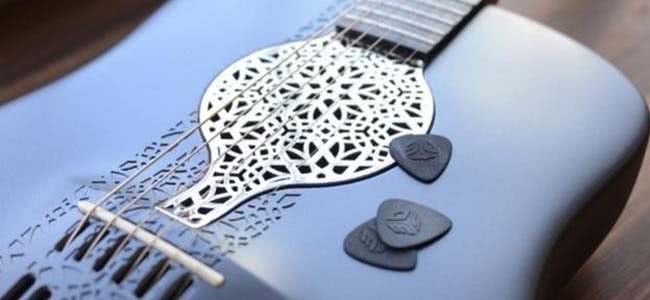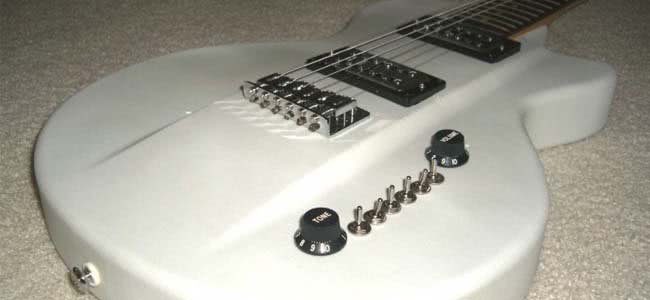Instead of pining after that 1968 Gibson Les Paul black beauty you’ve had your eye on forever, but couldn’t justify the $5,000+ pricetag, you could soon be printing that exact guitar for yourself, thanks to advancements in 3D printing.
A guitar pickup specialist store AweSome Musical Instruments have unveiled the very first, fully functioning and commercially available 3D-printed guitar made in the US, reports Gizmag.
The Les Paul-style AWE-3DG is touted as virtually impossible to break, and sports a “bank of rather interesting pickup selectors that open the door to otherwise hidden coil combinations for up to 76 different analog tones.” In layman’s terms, that’s a lot of pretty sweet sounds.
The US manufacturers of this marvel guitar are keeping mum on the majority of information on their creation, except that the white body has been completely fashioned through 3D printing. According to Gizmag, the 3D manufacturing process has been used to create the 1.6inch (41 mm) thick hollow body of the AWE-3DG guitar, but it has been printed using “glass-filled nylon”, which results in a “natural off-white colour”.
The 25.5-inch scale neck of the instrument hasn’t been printed, instead it’s been traditionally fashioned from maple with a “satin finish on the back, and a glossy front to the head.” They’ve added 0.008 to 0.038 gauge Ernie Ball Extra Slinky strings to create a 3kg mammoth guitar set with chrome tuners, state-of-the-art pickups, and a hardtail bridge with adjustable saddles. …This development in 3D printing is a huge step not only for technology, but also the future of buying, sharing, and creating musical instruments.
Apart from being eye-porn for every guitar playing enthusiast, this development in 3D printing is a huge step not only for technology, but also the future of buying, sharing, and creating musical instruments.
But what exactly is 3D printing, and how does it differ from basic manufacturing? At its most basic understanding, 3D printing is a form of additive manufacturing which can shape a solid, three-dimensional object from a digital model. The printing is through a process of adding layers of materials that are laid down in different shapes; this additive process is contradictory to regular manufacturing which relies on cutting, shaping and refining material, namely, subtractive processes.
Just last week there came the the highly criticised news of Cody Wilson and his company Defense Distributed create and share digital prints of their very own miniature handgun, as Forbes reports. The functioning gun, which he printed and trialled from a second hand 3D printer, can shoot .380 calibre bullets from its plastic exterior.
Currently used to regularly create prototypes, 3D printing can take anywhere from several hours to several days depending on the complexity and materials used.
Though no price for the new 3D printed Les Paul has been released yet, it will surely be attached to a hefty price at first, so why invest when you could just pick up a regular Les Paul from your friendly music store? Well, aside from AweSome’s newest 3D guitar being completely playable, its touted as a marvel for the future of music instrumentation due to its ties with digital alteration and personalisation.
Instead of purchasing your run-of-the-mill Fender Stratocaster, prospective buyers could personalise their own bases in terms of sound, quality, and colour on digital prints and eventually build their instrument any way they would want, almost completely cutting out the manufacturer.
In fact, the production of personal designs have already begun, with TechnoSnap noting that a New Zealand professor, Olaf Digel, has begun creating fancy web-like open base designs using wood, Polyamide 2200, and Alumide to construct some visually stunning guitar bodies.
Then there’s the fused plastic acoustic guitar that 3D Systems user Scott Summit created in the hopes of creating a guitar like Jerry Garcia’s. Businessweek reveals that Summit was skeptical of the model at first, noting he “thought it would at least be cool if the guitar exploaded” during the stringing process. The guitar survived and Summit’s body part printing startup has since been acquired by 3D Systems, a manufacturer of personal 3D printers.
Music Journalist Alan Cross ponders another issue that will soon plague manufacturers insofar as “if you had the file for printing, say, a guitar, might someone somewhere not invent a Napster- or Pirate Bay-like site for trading in this stuff?” Directing towards a TechCrunch report about the possibility of peer-to-peer shared ‘physibles’, the digital designs for 3d printed objects, including both the aforementioned musical instruments, but also – rather terrifyingly – weapons.




































